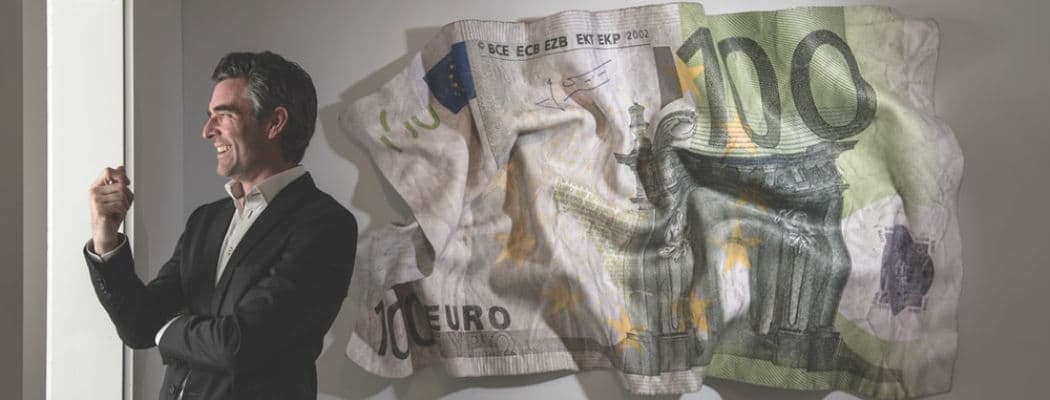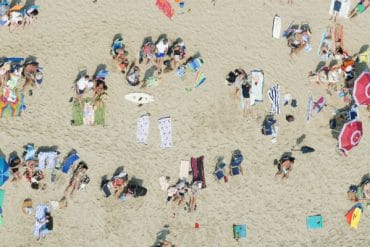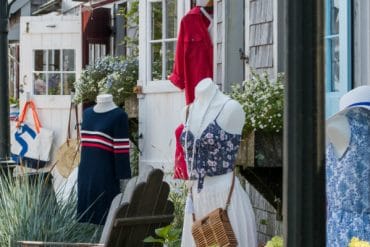The modern art trend on Nantucket.
 The art market on Nantucket traditionally conjures the quintessential seascape, oil paintings of Brant Point or acrylics of the downtown skyline looming in the distance. But over the last decade, contemporary art has been on the rise and now makes up a significant share of the market, with several prominent galleries dealing almost exclusively in the genre.
The art market on Nantucket traditionally conjures the quintessential seascape, oil paintings of Brant Point or acrylics of the downtown skyline looming in the distance. But over the last decade, contemporary art has been on the rise and now makes up a significant share of the market, with several prominent galleries dealing almost exclusively in the genre.
“The trends we are seeing now relate to an overall trend in decorating more than anything else,” says Ron Cavalier, owner of the Cavalier Gallery since 2000. Cavalier’s gallery features a wide variety of representational, contemporary, photographic, and abstract art forms. “Younger buyers want something different than what mom and grandma had on the walls.”
Interior designer Kathleen Hay wholeheartedly agrees with this view. “We have definitely seen the acceptance of all things modern in art and decoration,” she explains. “It’s actually kind of startling to see how contemporary Nantucket has gotten, and a big driving force with my clients is that they don’t want to have what everyone else has; they want a different approach.”
 Hay says she was first cognizant of the trend away from the layered, “beachy” Nantucket interiors of soft blues and yellows back in 2006 after decorating a spec home in a very contemporary style and seeing a hugely positive response. “I’ve personally been so grateful for the shift away from the predictable, each job is so different now.”
Hay says she was first cognizant of the trend away from the layered, “beachy” Nantucket interiors of soft blues and yellows back in 2006 after decorating a spec home in a very contemporary style and seeing a hugely positive response. “I’ve personally been so grateful for the shift away from the predictable, each job is so different now.”
While it may appear to be an emerging trend, non-representational art is actually nothing new on Nantucket. Back in 1945, there was a small but vocal group of artists that objected to the newly formed Artists’ Association of Nantucket. The majority of the Association’s founding members wanted the organization to focus on traditional, representational art. But there was a segment of modern artists, known as the ’45 Group, who felt they were going to be excluded, or worse, forgotten. These painters represented the first of the modern art movement on Nantucket.
“This was a group that split off and was far more adventurous for the time,” says Reggie Levine, a long-time Nantucket resident, artist, and former owner of The Main Street Gallery, which dominated the Nantucket arts scene in the 1970s and eighties. “This was the first time you saw a change taking place. Abstract was there in the seventies at the Main Street Gallery, but at that time, abstract was not a shock… But it took those thirty years to get there.”
Nantucket’s reluctant and languorous trek toward the acceptance of the modern and abstract art was a reflection of the population, says Levine. “The population was historically very disciplined and conservative. Then, in the sixties, the [real estate] market opened up when there was a rush to buy property, bringing a whole different group of people with a whole other attitude,” he explains. “They weren’t as enamored with the island’s history, and that long held conservatism went out the window with some of the younger people that arrived. This was an extraordinary influx of people, and they had very strong feelings about what constituted art.”
 It was only a few years after this occurrence that Levine opened his Main Street Gallery, and proudly represented the works of many contemporary Nantucket artists, in addition to his own work. “Abstract, non-representational art dominated the scene during the time of the Main Street Gallery, and Reggie was one of the first to highlight great artists from places like New York and New Jersey,” says Bobby Frazier, an island artist and the Artists’ Association’s curator of exhibitions.
It was only a few years after this occurrence that Levine opened his Main Street Gallery, and proudly represented the works of many contemporary Nantucket artists, in addition to his own work. “Abstract, non-representational art dominated the scene during the time of the Main Street Gallery, and Reggie was one of the first to highlight great artists from places like New York and New Jersey,” says Bobby Frazier, an island artist and the Artists’ Association’s curator of exhibitions.
After the Main Street Gallery closed in the 1980s, the X Gallery picked up the mantle of the modern movement on Nantucket, further cementing non-representational art’s gradual climb up the ladder of popularity. “The art scene on Nantucket has always had a dominant gallery at a given time,” says Frazier. “And the X Gallery was all about non-representational art, setting the stage, and establishing the strength of the scene for the galleries from Greenwich and New York, and others in the years to come.”
The 1990s and early 2000s saw a return to representational dominance, and was likely influenced by the fashions of the period, the dominant ideas in interior design, and, most importantly, the stable of artists creating works at the time. To some, this suggests something of a cyclical nature as it relates to the sales market. “There’s been galleries handling modern and the contemporary for a long time on Nantucket,” says Ron Cavalier. “But then representational sales went blockbuster for years,” he adds, referring to that period around the turn of this century.
 Lee Milazzo, owner of the Samuel Owen Gallery on Centre Street is entering his third year in business and says the expansion from his Greenwich, Connecticut storefront was led by the opportunity to open shop in a place he believed was still under-representing contemporary artists and pieces.
Lee Milazzo, owner of the Samuel Owen Gallery on Centre Street is entering his third year in business and says the expansion from his Greenwich, Connecticut storefront was led by the opportunity to open shop in a place he believed was still under-representing contemporary artists and pieces.
“It was the same in Greenwich, too, at the time we started our gallery there,” he says, referring to himself and his wife, Cynthia. “There were a lot of traditional and representative galleries and just about everything was a sailing ship or a scene of the Hudson River. I love representational art, but that’s not what I was trained in or personally collect. So the first thing that attracted me to Greenwich and Nantucket was to put a gallery like ours in a place with a backdrop that really made it stand out.”
While Milazzo represents several locals such as surf and fine art photographer Jonathan Nimerfroh, many of his artists are based around the country. “The reception has been great, better than expected,” he says.
Levine also speaks to this point: “Take a look at the galleries today. Some of them have been quite adventurous and have really gone out of the way to show more and more abstract, and have made the modern movement more prevalent due to these galleries pushing it to some degree,” he says.
 Both Milazzo and Cavalier agreed that no matter what the trends may be, they focus on signing artists who are talented beyond reproach, with the defining characteristic being that their work transcends time, place, and what happens to be in fashion. For those whose tastes still firmly lie in the representational and traditional, Levine says collectors need not fear: “The harbor scenes, the shingles, and the seagulls will always be with us.”
Both Milazzo and Cavalier agreed that no matter what the trends may be, they focus on signing artists who are talented beyond reproach, with the defining characteristic being that their work transcends time, place, and what happens to be in fashion. For those whose tastes still firmly lie in the representational and traditional, Levine says collectors need not fear: “The harbor scenes, the shingles, and the seagulls will always be with us.”
From Hay’s perspective, the shift back to representational art having an edge in the market may already be in motion. “It will be interesting to see what comes back in fashion,” she says. “In my mind it has to do with the people coming in. It’s a very worldly and well-traveled group, which could represent a big, unexpected change in the years to come.” At the end of the day, adds Cavalier, “Buy what you love; buy what you love; buy what you love.”






